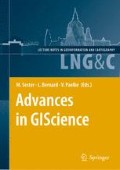Abstract. We study a point pattern detection problem on networks, motivated by
geographical analysis tasks, such as crime hotspot detection. Given a network N (for example, a street, train, or highway network) together with a set of sites which are located on the network (for example, accident locations or crime scenes), we want to find a connected subnetwork F of N of small total length that contains many sites. That is, we are searching for a subnetwork F that spans a cluster of sites which are close with respect to the network distance.
We consider different variants of this problem where N is either a general graph or restricted to a tree, and the subnetwork F that we are looking for is either a simple path, a path with self-intersections at vertices, or a tree. Many of these variants are NP-hard, that is, polynomial-time solutions are very unlikely to exist. Hence we focus on exact algorithms for special cases and efficient algorithms for the general case under realistic input assumptions.
Access this chapter
Tax calculation will be finalised at checkout
Purchases are for personal use only
Preview
Unable to display preview. Download preview PDF.
References
Aerts, K., Lathuy, C., Steenberghen, T., and Thomas, I. (2006). Spatial clustering of traffic accidents using distances along the network. In Proc. 19th Workshop Intern. Cooperation on Theories and Concepts in Traffic Safety.
Arkin, E. M., Mitchell, J. S. B., and Narasimhan, G. (1998). Resource-constrained geometric network optimization. In Proc. 14th Symp. Computational Geometry, pages 307–316.
Awerbuch, B., Azar, Y., Blum, A., and Vempala, S. (1998). New approximation guarantees for minimum-weight k-trees and prize-collecting salesmen. SIAM Journal on Computing, 28(1):254–262.
Beineke, L. W. and Pippert, R. R. (1971). The number of labeled dissections of a k-ball. Math. Ann., 191:87–98.
Bender, M. A., Farach-Colton, M., Pemmasani, G., Skiena, S. S., and Sumazin, P. (2005). Lowest common ancestors in trees and directed acyclic graphs. Journal of Algorithms, 57(2):75–94.
Blum, A., Chawla, S., Karger, D. R., Lane, T., Meyerson, A., and Minkoff, M. (2007). Approximation algorithms for orienteering and discounted-reward TSP. SIAM Journal on Computing, 37(2):653–670.
Bodlaender, H. (2007). Treewidth: Structure and algorithms. In Proc. 14th Colloquium on Structural Information and Communication Complexity, number 4474 in LNCS, pages 11–25.
Celik, M., Shekhar, S., George, B., Rogers, J. P., and Shine, J. A. (2007). Discovering and quantifying mean streets: A summary of results. Technical Report 07–025, University of Minnesota -Comp. Science and Engineering.
Chekuri, C., Korula, N., and P´al, M. (2008). Improved algorithms for Orienteering and related problems. In Proc. 19th ACM-SIAM Symp. Discrete Algorithms, pages 661–670.
Chen, K. and Har-Peled., S. (2006). The orienteering problem in the plane revisited. In Proc. 22nd Symp. Computational Geometry, pages 247–254.
Cormen, T. H., Leiserson, C. E., Rivest, R. L., and Stein, C. (2001). Introduction to Algorithms. MIT Press and McGraw-Hill, 2nd edition.
Fotheringham, S. and Rogerson, P. (1994). Spatial Analysis and GIS. Taylor and Francis, London.
Golden, B., Levy, L., and Vohra, R. (1987). The orienteering problem. Naval Research Logistics, 34:307–318.
Illinois Criminal Justice Information Authority (1996). STAC user manual.
Kloks, T. (1993). Treewidth. PhD thesis, Utrecht University.
Levine, N. (2005). Crime mapping and the Crimestat program. Geographical Analysis, 38:41–56.
Miller, H. and Han, J., editors (2001). Geographic Data Mining and Knowledge Discovery. CRC Press.
Okabe, A., Okunuki, K., and Shiode, S. (2006). Sanet: A toolbox for spatial analysis on a network. Geographical Analysis, 38(1):57–66.
O’Sullivan, D. and Unwin, D. (2002). Geographic Information Analysis. Wiley.
Ratcliffe, J. H. (2004). The hotspot matrix: A framework for the spatio-temporal targeting of crime reduction. Police Practice and Research, 5:05–23.
Ratcliffe, J. H. and McCullagh, M. J. (1998). Aoristic crime analysis. International Journal of Geographical Information Science, 12:751–764.
Rich, T. (2001). Crime mapping and analysis by community organizations in hart-ford, connecticut. National Institute of Justice: Research in Brief, pages 1–11.
Rote, G. (1997). Binary trees having a given number of nodes with 0, 1, and 2 children. S´eminaire Lotharingien de Combinatoire, B38b:6 pages.
Spooner, P. G., Lunt, I. D., Okabe, A., and Shiode, S. (2004). Spatial analysis of roadside Acacia populations on a road network using the network k-function. Landscape Ecology, 19:491–499.
Steenberghen, T., Dufays, T., Thomas, I., and Flahaut, B. (2004). Intra-urban location and clustering of road accidents using GIS: a Belgian example. International Journal of Geographical Information Science, 18:169–181.
Stillwell, J. and Clarke, G. (2005). Applied GIS and Spatial Analysis. Wiley.
Yamada, I. and Thill, J. (2007). Local indicators of network-constrained clusters in spatial point patterns. Geographical Analysis, 39:268–292.
Author information
Authors and Affiliations
Corresponding author
Editor information
Editors and Affiliations
Rights and permissions
Copyright information
© 2009 Springer-Verlag Berlin Heidelberg
About this paper
Cite this paper
Buchin, K. et al. (2009). Detecting Hotspots in Geographic Networks. In: Sester, M., Bernard, L., Paelke, V. (eds) Advances in GIScience. Lecture Notes in Geoinformation and Cartography. Springer, Berlin, Heidelberg. https://doi.org/10.1007/978-3-642-00318-9_11
Download citation
DOI: https://doi.org/10.1007/978-3-642-00318-9_11
Published:
Publisher Name: Springer, Berlin, Heidelberg
Print ISBN: 978-3-642-00317-2
Online ISBN: 978-3-642-00318-9
eBook Packages: Earth and Environmental ScienceEarth and Environmental Science (R0)

